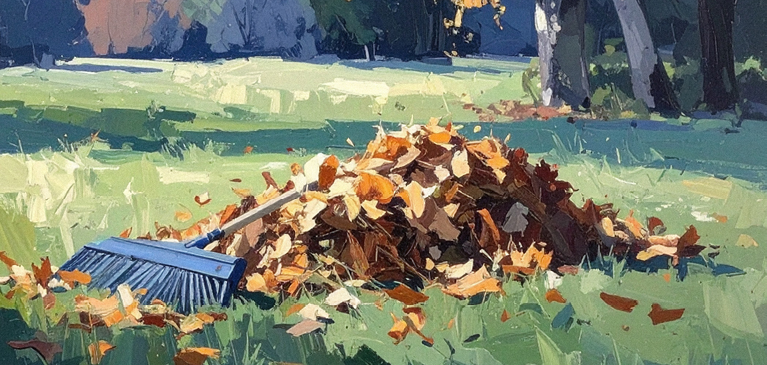
We are all well acquainted with a warm summer that allows us to perfectly set up our landscapes, gardens, and patios. But, that means we have to take the time in the fall to clean up a bit and prepare our land for the harsher winter. As you start your fall cleanup, we hope these tips can help your land thrive this winter season!
First things first, things like the grill, patio furniture, air conditioner, and the garden hose should be one of the first priorities. Making sure each of them are clean, covered, and put away will make the spring much easier when you go to use them again. Putting away any summer lawn or garden décor at the same time will ensure nothing gets lost or broken and creates space for fall and winter décor!
Garden and flower beds can be a bit trickier, let’s break the pieces down.
Perennials will come back year after year if they are healthy enough. This fall, remove any branches that are dead or diseased to promote healthy growth this spring. Dead or diseased branches when weighed down with snow or ice can cause damage to healthy parts of the plant. You should also identify how large your perennials are, this is the best time of year to divide them. Dividing perennials allows for more root space, prevents overgrowth, and creates extra plants to share with friends or plant elsewhere!
Annuals do not come back; many may have already died by this time of year or are on their way out. Make sure to remove all parts of the annual flowers (and any weeds). Leaving annuals will encourage pests or diseases as the plant decomposes over the winter, making spring planting more difficult. Cleaning the dead debris out will give you a nice blank planting canvas for next spring.
Tender vegetables are unable to tolerate frost. Crops like tomatoes, peas, or pumpkins should be harvested completely before frost comes, including dead debris. Semi-hardy and hardy vegetables can wait a little longer, they often survive the light frosts and may even taste better after a late harvest.
Composting in the spring is a common practice, but adding a layer of compost over your garden beds for the winter will allow the soil to soak up nutrients while there is nothing growing. Adding a two-to-three-inch layer of straw, leaves, grass clippings, or even pine needles overtop of the compost will help to reduce weed development, nutrient leaching, and keep the soil temperature regulated.
Another option to compost and mulching is a winter cover crop! Depending on what nutrients your soil lacks, crops like cereal rye, winter wheat and hairy vetch will endure a harsh winter and return valuable nutrients to your soil next spring. Planting a cover crop before the first frost will allow for sustainable growth and survival.
Whether cleanup is a family affair or a solo serenade, ensuring a proper cleanup will ensure your garden or landscape looks perfect when it’s time to bring the grill and furniture back out in the spring!
To view the rest of the 2025 fall Partners articles please click here.
First things first, things like the grill, patio furniture, air conditioner, and the garden hose should be one of the first priorities. Making sure each of them are clean, covered, and put away will make the spring much easier when you go to use them again. Putting away any summer lawn or garden décor at the same time will ensure nothing gets lost or broken and creates space for fall and winter décor!
Garden and flower beds can be a bit trickier, let’s break the pieces down.
Perennials will come back year after year if they are healthy enough. This fall, remove any branches that are dead or diseased to promote healthy growth this spring. Dead or diseased branches when weighed down with snow or ice can cause damage to healthy parts of the plant. You should also identify how large your perennials are, this is the best time of year to divide them. Dividing perennials allows for more root space, prevents overgrowth, and creates extra plants to share with friends or plant elsewhere!
Annuals do not come back; many may have already died by this time of year or are on their way out. Make sure to remove all parts of the annual flowers (and any weeds). Leaving annuals will encourage pests or diseases as the plant decomposes over the winter, making spring planting more difficult. Cleaning the dead debris out will give you a nice blank planting canvas for next spring.
Tender vegetables are unable to tolerate frost. Crops like tomatoes, peas, or pumpkins should be harvested completely before frost comes, including dead debris. Semi-hardy and hardy vegetables can wait a little longer, they often survive the light frosts and may even taste better after a late harvest.
Composting in the spring is a common practice, but adding a layer of compost over your garden beds for the winter will allow the soil to soak up nutrients while there is nothing growing. Adding a two-to-three-inch layer of straw, leaves, grass clippings, or even pine needles overtop of the compost will help to reduce weed development, nutrient leaching, and keep the soil temperature regulated.
Another option to compost and mulching is a winter cover crop! Depending on what nutrients your soil lacks, crops like cereal rye, winter wheat and hairy vetch will endure a harsh winter and return valuable nutrients to your soil next spring. Planting a cover crop before the first frost will allow for sustainable growth and survival.
Whether cleanup is a family affair or a solo serenade, ensuring a proper cleanup will ensure your garden or landscape looks perfect when it’s time to bring the grill and furniture back out in the spring!
To view the rest of the 2025 fall Partners articles please click here.


